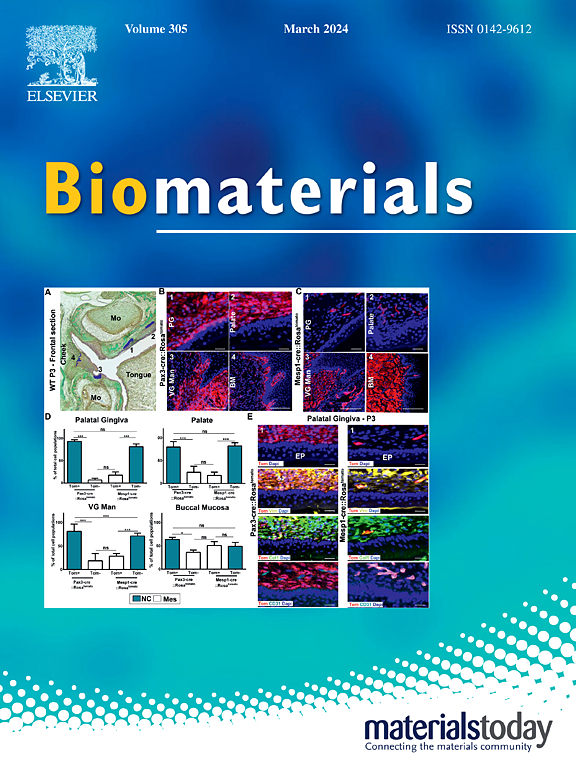CD44 and αV-integrins dual-targeting bimetallic nanozymes for lung adenocarcinoma therapy via NIR-enhanced ferroptosis/apoptosis
IF 12.9
1区 医学
Q1 ENGINEERING, BIOMEDICAL
引用次数: 0
Abstract
Combination therapy is a promising strategy for lung adenocarcinoma (LUAD), due to the advantages of overcoming drug resistance, side effects, and tumor heterogeneity. Herein, we report a novel dual-targeting bimetallic nanozyme (MH-iRGD) consisting of nanosized manganese ferrite (MF) after encapsulating with dopamine and methacrylic anhydride to modify hyaluronic acid, followed by integrin receptor targeting peptide (HS-PEG3400-iRGD) modification for LUAD targeted therapy. Our study confirmed that MH-iRGD combined with near-infrared irradiation (NIR) possessed dramatic photothermal effects and reactive oxygen species (ROS) production and GSH depletion abilities. Importantly, MH-iRGD possessed dual-targeting capacities for LUAD cells overexpressed CD44 and αV-integrin receptors owing to hyaluronic acid coating and iRGD modification. Inhibitors of CD44 and integrins could impair the uptake of MH-iRGD in LUAD cells. Moreover, MH-iRGD + NIR displayed excellent anti-LUAD effects as a result of the production of intracellular ROS, consumption of glutathione (GSH) and mitochondrial dysfunction. Mechanistically, NIR robustly strengthened MH-iRGD-induced ferroptosis and apoptosis by down-regulating SLC7A11, GPX4, Bcl-2 levels while up-regulating Bax level. Specifically, ferroptosis and apoptosis were increased while the LUAD progression was inhibited after intravenous injection of MH-iRGD + NIR in xenograft mouse models. Taken together, our results indicate that MH-iRGD + NIR serves as a promising targeted therapy for LUAD, which broadens the applications of highly active dual-targeting bimetallic nanozymes.

CD44和α v -整合素双靶向双金属纳米酶通过nir增强的铁下垂/凋亡治疗肺腺癌
由于克服了耐药、副作用和肿瘤异质性的优点,联合治疗是治疗肺腺癌(LUAD)的一种很有前途的策略。本文报道了一种新的双靶向双金属纳米酶(MH-iRGD),由纳米级铁酸锰(MF)包裹多巴胺和甲基丙烯酸酐修饰透明质酸,然后修饰整合素受体靶向肽(HS-PEG3400-iRGD)用于LUAD靶向治疗。我们的研究证实了MH-iRGD联合近红外照射(NIR)具有显著的光热效应和活性氧(ROS)的产生和GSH的消耗能力。重要的是,由于透明质酸涂层和iRGD修饰,MH-iRGD具有双靶向LUAD细胞过表达CD44和α v整合素受体的能力。CD44和整合素抑制剂可损害LUAD细胞对MH-iRGD的摄取。此外,MH-iRGD + NIR由于细胞内ROS的产生、谷胱甘肽(GSH)的消耗和线粒体功能障碍而表现出优异的抗luad作用。机制上,NIR通过下调SLC7A11、GPX4、Bcl-2水平,上调Bax水平,增强了h - irgd诱导的铁凋亡和细胞凋亡。在异种移植小鼠模型中,静脉注射MH-iRGD + NIR后,铁下垂和细胞凋亡增加,LUAD进展受到抑制。综上所述,我们的研究结果表明,MH-iRGD + NIR是一种有希望的LUAD靶向治疗方法,这拓宽了高活性双靶向双金属纳米酶的应用范围。
本文章由计算机程序翻译,如有差异,请以英文原文为准。
求助全文
约1分钟内获得全文
求助全文
来源期刊

Biomaterials
工程技术-材料科学:生物材料
CiteScore
26.00
自引率
2.90%
发文量
565
审稿时长
46 days
期刊介绍:
Biomaterials is an international journal covering the science and clinical application of biomaterials. A biomaterial is now defined as a substance that has been engineered to take a form which, alone or as part of a complex system, is used to direct, by control of interactions with components of living systems, the course of any therapeutic or diagnostic procedure. It is the aim of the journal to provide a peer-reviewed forum for the publication of original papers and authoritative review and opinion papers dealing with the most important issues facing the use of biomaterials in clinical practice. The scope of the journal covers the wide range of physical, biological and chemical sciences that underpin the design of biomaterials and the clinical disciplines in which they are used. These sciences include polymer synthesis and characterization, drug and gene vector design, the biology of the host response, immunology and toxicology and self assembly at the nanoscale. Clinical applications include the therapies of medical technology and regenerative medicine in all clinical disciplines, and diagnostic systems that reply on innovative contrast and sensing agents. The journal is relevant to areas such as cancer diagnosis and therapy, implantable devices, drug delivery systems, gene vectors, bionanotechnology and tissue engineering.
 求助内容:
求助内容: 应助结果提醒方式:
应助结果提醒方式:


